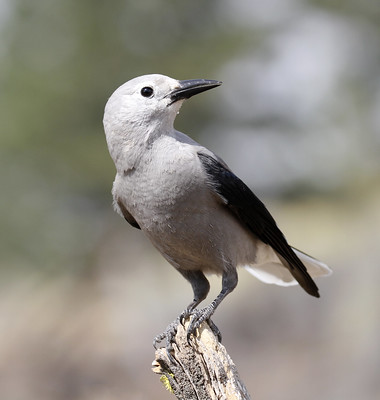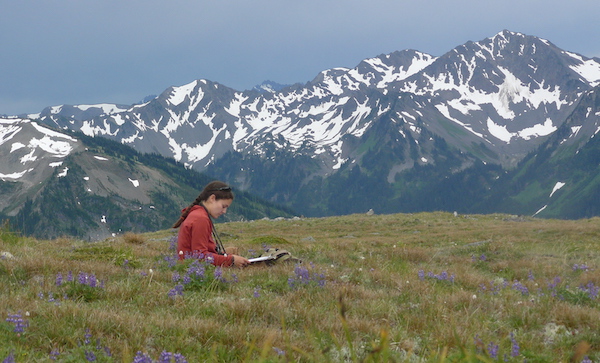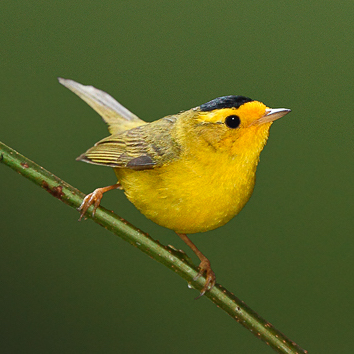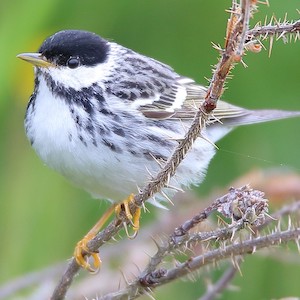In uncertain times, nature's rhythms can provide comfort; the trees still leaf out, the flowers still bloom and the birds still sing. And while there is much concern about declining bird populations, there is also some good news.
Two recent IBP studies of bird populations in the national parks of the Pacific Northwest show that most species are stable or even increasing. The first study investigated the effects of climate change on birds in the region's largest wilderness parks– Olympic, Mount Rainer, and North Cascades National Park. The second study looked at how bird populations were faring in two smaller, non-wilderness parks– San Juan Island National Historical Park and Lewis and Clark National Historical Park. These smaller parks have natural habitat, but their primary purpose is to protect historical sites.

Golden-crowned Kinglet. Photo by Francesco Veronesi/Flickr.
The data in these studies was collected as part of the National Park Service's (NPS) North Coast and Cascades Inventory and Monitoring Network (NCCN.) This is part of the NPS's Inventory and Monitoring Program. Bird populations are considered "vital signs" of the parks because–like canaries in the coal mine–their abundance can reflect the condition of resources and presence of ecological stressors in the park.
Since 2005, IBP field crews have conducted almost 14,000 point counts and collectively hiked over 10,000 miles, as part of our work with NPS conducting monitoring surveys in the seven parks in the NCCN. IBP has been working with the National Park Service’s Inventory and Monitoring program since it began in Yosemite National Park in 1998. When the program started in the NCCN, IBP helped develop the protocol for assessing bird populations in the parks and conducted the initial "inventory phase" of the surveys.
The monitoring surveys are not just "a walk in the park." Many of them are conducted in the backcountry and field technicians must be skilled. Mandy Holmgren, the IBP staff biologist who leads these crews, describes how technicians are trained:

Mandy Holmgren training crew members. Photo by Chris Ray.
We start each year off with a 3-week long training session, where field technicians learn how to identify (by sight and sound) all the birds typically found in the Pacific Northwest parks during the breeding season. We visit as many different habitat types as possible across the parks during training, spending a good portion of each day on bird identification, and much of the rest of the day hiking and getting our bodies ready for the season! We don't allow anyone to go into the field to collect point count data on their own until they have passed a rigorous bird identification exam and we feel comfortable enough with their skills to let them loose.
But collecting data is only part of the work. Figuring out what the data means is no mean feat either. That's where IBP research ecologist Chris Ray comes in. Her work with IBP focuses on hierarchical modeling of avian point count data and she has a special interest in how populations respond to habitat fragmentation and climate change. Ray says that determining if a bird species is declining isn't as easy as you might think:
It would be great if you could just do a count every year, plot the annual numbers on a chart, and decide based on whether your counts are trending up or down. But if the count is going up, it could be that your crew is just getting better every year at detecting the species. . . And if the count is going down, maybe it's because you're conducting it at a time of year that's less and less optimal for detecting the species. Instead of fewer birds out there, maybe they're just shifting their activities to earlier and earlier in the year in response to climate change.
We have to account for things like this, to see if changes in our counts might be explained by things other than a change in population size. It's a lot like presenting evidence in court. A population is innocent of change until there's enough evidence against the assertion that it's stable. So I spend a lot of my time figuring out how nuisance variables like detection probability might be affecting our counts.
One of the things Ray has to account for is what she calls "the Mandy effect." Mandy refers to Holmgren, who has been leading the IBP crews on this project since 2006. Mandy is REALLY good at her job, so good that Ray has to figure her into the mathematical models:
When we're trying to estimate the size of a population--how many birds are really out there--half the battle is figuring out what fraction of the population we're able to count. And different people have different abilities when it comes to counting birds. I think everyone suspected that Mandy was really good at it, but now we have proof. I used our count data in a model that estimates what we call an "observer effect", and it showed clearly that Mandy detects significantly more birds than the average trained observer. That's the Mandy effect.
Ray notes that the Mandy effect isn't the only thing that can affect the number of birds you detect during a point count:
All sorts of things affect our counts. The weather and the date and even the time of day affect how often birds sing. Our ability to hear them sing is affected by noise from streams and wind and traffic. We track all these variables, and use some great models to figure out which ones are affecting our counts and by how much.
And now the good news. The first study looked at bird populations between 2005-2014 in the three large wilderness parks of the Pacific Northwest: Mount Rainier, North Cascades, and Olympic National Parks. These parks are ideal areas to look at the effects of climate change on bird populations, because they are relatively free of other human disturbance like roads, logging, development, etc., making the effects of climate easier to isolate.

Clark's Nutcracker. Photo by Robin Agarwal/Flickr.
Ray and co-authors focused on effects of changing precipitation and temperature. Precipitation, especially snow, at breeding sites had a larger effect on bird populations than did mean spring temperature. But overall the effect of climate on bird populations in the park were weak. Of the 39 bird species considered, only 6 species (Northern Flicker, Olive-sided Flycatcher, Clark's Nutcracker, Mountain Chickadee, Red-breasted Nuthatch and Dark-eyed Junco) showed evidence of a decline during the 12-year study period. But most of these 6 species appeared to decline in only one park, while remaining stable or even increasing in the other parks in the study. The authors surmise that birds are likely able to tolerate climate change up to a certain point, but note that more extreme changes could lead to declines. For now though, bird populations in Mount Rainier, North Cascades, and Olympic National Parks are doing well.
It makes sense that bird populations are thriving in the large, mostly untouched parks in the Pacific Northwest region, but what about smaller, more human-altered parks? The second study looked at trends in bird populations at San Juan Island National Historic Park and Lewis and Clark National Historical Park. These parks are smaller, more fragmented, and surrounded by more developed areas. They include natural habitat but little if any old growth forest, and they are home to more invasive species than the larger parks. You might suspect that bird population trends in these parks would reflect the declining trends we see more broadly across North America.
But even in these parks bird populations were doing well. Populations of all 40 bird species considered in the San Juan Island National Historic Park analysis were stable or increasing during the 12-year study. In Lewis and Clark National Historical Park, only 3 of 39 species considered were declining. These were Northern Flicker, Olive-sided Flycatcher, and Hutton’s Vireo. Even so, trends in these smaller parks were generally more positive than in the surrounding regions.
Even as the world and our climate are changing, our parks offer hope. These studies illustrate the importance of national parks and show that protected areas, both large and small, can serve as vital habitat for birds.






